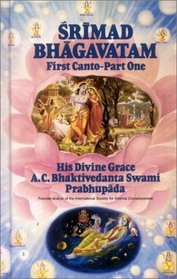Search -
Srimad Bhagavatam: First Canto 'Creation' (Chapters 1-7)
Srimad Bhagavatam First Canto 'Creation' - Chapters 1-7
Author:
This book contains the original sanskrit, a direct translation word for word, then a regular translation, and a commentary "purport". This is done for each paragraph — Book 1 (This book) — The first book introduces the Bhāgavata, with Saunaka gathering the sages in Naimisha Forest to hear Sūta praise bhakti to Krishna and ... more »
Author:
This book contains the original sanskrit, a direct translation word for word, then a regular translation, and a commentary "purport". This is done for each paragraph — Book 1 (This book) — The first book introduces the Bhāgavata, with Saunaka gathering the sages in Naimisha Forest to hear Sūta praise bhakti to Krishna and ... more »
ISBN-13: 9780912776279
ISBN-10: 0912776277
Publication Date: 1998
Pages: 488
Rating: 4
ISBN-10: 0912776277
Publication Date: 1998
Pages: 488
Rating: 4
3.9 stars, based on 4 ratings
Genres:
- Religion & Spirituality >> Bible & Other Sacred Texts
- Religion & Spirituality >> Hinduism >> Bhagavad Gita
- Religion & Spirituality >> Hinduism >> Hare Krishna
- Religion & Spirituality >> Hinduism >> Sanskrit
- Religion & Spirituality >> New Age & Spirituality >> General
- Religion & Spirituality >> Religious Studies





